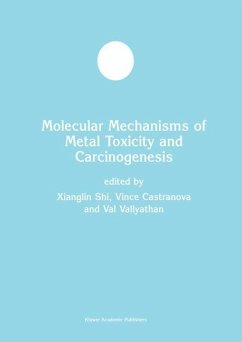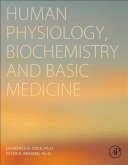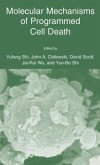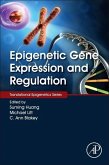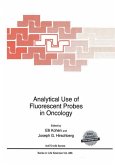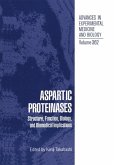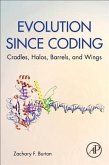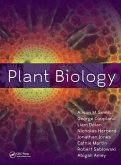Xianglin Shi, Vince Castranova, Val Vallyathan
Molecular Mechanisms of Metal Toxicity and Carcinogenesis
Xianglin Shi, Vince Castranova, Val Vallyathan
Molecular Mechanisms of Metal Toxicity and Carcinogenesis
- Gebundenes Buch
- Merkliste
- Auf die Merkliste
- Bewerten Bewerten
- Teilen
- Produkt teilen
- Produkterinnerung
- Produkterinnerung
During the last two decades, chemical and cellular studies have contributed enormously to our understanding of metal-induced carcinogenesis, and many hypotheses on the role of metals in pathophysiological processes have been investigated. In addition, new techniques are available to shed light on the mechanism of carcinogenesis in molecular terms. This conference on Molecular Mechanisms of Metal Toxicity and Carcinogenesis in September 2000 focused on the latest research in molecular mechanisms of metal-induced toxicity and carcinogenesis. The conference promoted a multidisciplinary…mehr
Andere Kunden interessierten sich auch für
![Human Physiology, Biochemistry and Basic Medicine Human Physiology, Biochemistry and Basic Medicine]() Laurence A. ColeHuman Physiology, Biochemistry and Basic Medicine157,99 €
Laurence A. ColeHuman Physiology, Biochemistry and Basic Medicine157,99 €![Molecular Mechanisms of Programmed Cell Death Molecular Mechanisms of Programmed Cell Death]() Yufang Shi / John A. Cidlowski / David W. Scott / Jia-Rui Wu / Yun Bo Shi (Hgg.)Molecular Mechanisms of Programmed Cell Death121,99 €
Yufang Shi / John A. Cidlowski / David W. Scott / Jia-Rui Wu / Yun Bo Shi (Hgg.)Molecular Mechanisms of Programmed Cell Death121,99 €![Epigenetic Gene Expression and Regulation Epigenetic Gene Expression and Regulation]() Epigenetic Gene Expression and Regulation147,99 €
Epigenetic Gene Expression and Regulation147,99 €![Analytical Use of Fluorescent Probes in Oncology Analytical Use of Fluorescent Probes in Oncology]() Elli Kohen / Joseph G. Hirschberg (Hgg.)Analytical Use of Fluorescent Probes in Oncology161,99 €
Elli Kohen / Joseph G. Hirschberg (Hgg.)Analytical Use of Fluorescent Probes in Oncology161,99 €![Aspartic Proteinases Aspartic Proteinases]() Kenji Takahashi (ed.)Aspartic Proteinases161,99 €
Kenji Takahashi (ed.)Aspartic Proteinases161,99 €![Evolution Since Coding Evolution Since Coding]() Zachary F. BurtonEvolution Since Coding53,99 €
Zachary F. BurtonEvolution Since Coding53,99 €![Plant Biology Plant Biology]() Alison M. Smith (UK John Innes Centre)Plant Biology87,99 €
Alison M. Smith (UK John Innes Centre)Plant Biology87,99 €-
-
-
During the last two decades, chemical and cellular studies have contributed enormously to our understanding of metal-induced carcinogenesis, and many hypotheses on the role of metals in pathophysiological processes have been investigated. In addition, new techniques are available to shed light on the mechanism of carcinogenesis in molecular terms. This conference on Molecular Mechanisms of Metal Toxicity and Carcinogenesis in September 2000 focused on the latest research in molecular mechanisms of metal-induced toxicity and carcinogenesis. The conference promoted a multidisciplinary investigative approach and included presentations from international experts on state-of-the-art information in this field.
Hinweis: Dieser Artikel kann nur an eine deutsche Lieferadresse ausgeliefert werden.
Hinweis: Dieser Artikel kann nur an eine deutsche Lieferadresse ausgeliefert werden.
Produktdetails
- Produktdetails
- Developments in Molecular and Cellular Biochemistry Vol. 34
- Verlag: Springer, Berlin
- Reprinted from MOLECULAR AND CELLULAR BIOCHEMISTRY, 2002
- Seitenzahl: 252
- Erscheinungstermin: 31. Dezember 2001
- Englisch
- Abmessung: 297mm x 210mm x 14mm
- Gewicht: 879g
- ISBN-13: 9780792374985
- ISBN-10: 0792374983
- Artikelnr.: 21302970
- Herstellerkennzeichnung Die Herstellerinformationen sind derzeit nicht verfügbar.
- Developments in Molecular and Cellular Biochemistry Vol. 34
- Verlag: Springer, Berlin
- Reprinted from MOLECULAR AND CELLULAR BIOCHEMISTRY, 2002
- Seitenzahl: 252
- Erscheinungstermin: 31. Dezember 2001
- Englisch
- Abmessung: 297mm x 210mm x 14mm
- Gewicht: 879g
- ISBN-13: 9780792374985
- ISBN-10: 0792374983
- Artikelnr.: 21302970
- Herstellerkennzeichnung Die Herstellerinformationen sind derzeit nicht verfügbar.
Molecular mechanisms of metal toxicity and carcinogenesis.
Cadmium
induced apoptosis and phenotypic changes in mouse thymocytes.
Cytotoxicity and transcriptional activation of stress genes in human liver carcinoma cells (HepG2) exposed to cadmium chloride.
Arsenic
induced NFiB transactivation through Erks
and JNKs
dependent pathways in mouse epidermal JB6 cells.
Lead
related effects on rat fibroblasts.
In vivoreduction of chromium (VI) and its related free radical generation.
Atrazine potentiation of arsenic trioxide
induced cytotoxicity and gene expression in human liver carcinoma cells (HcpG2).
CombiningDmsophila melanogastersomatic
mutation
recombination and electron
spin
resonance
spectroscopy data to interpret epidemiologic observations on chromium carcinogenicity.
Carcinogenic potential and genomic instability of beryllium sulphate in BALB/c
3T3 cells.
Cr (VI) induces cell growth arrest through hydrogen peroxide
mediated reactions.
Comparison of roles of three mitogen
activated protein kinases induced by chromium(VI) and cadmium in non
small
cell lung carcinoma cells.
Differential zinc and DNA binding by partial peptides of human protamine HP2.
Reduction of Cr (VI) by cysteine: Significance in human lymphocytes and formation of DNA damage in reactions with variable reduction rates.
Transactivation of RARE and GRE in the cellular response to arsenic.
Orthopaedic implant related metal toxicity in terms of human lymphocyte reactivity to metal
protein complexes produced from cobalt
base and titanium
base implant alloy degradation.
Arsenic contamination of groundwater and prevalence of arsenical dermatosis in the Hetao plain area, Inner Mongolia, China.
Involvement of Erks activation in cadmium
induced AP
1 transactivationin vitroandin vivo.
Chromium (VI)
induced oxidative stress, apoptotic cell death and modulation of p53 tumor suppressor gene.
Review.
Carcinogenic metals and NF
?B activation.
Effects of glutathione on chromium
induced DNA crosslinking and DNA polymerase arrest.
Minireview.
Cell apoptosis induced by carcinogenic metals.
Gene expression profile in response to chromium
induced cell stress in A549 cells.
Cr (VI) increases tyrosine phosphorylation through reactive oxygen species
mediated reactions.
Molecular biology of nickel carcinogenesis.
Model reactions of Cr (VI) with DNA mediated by thiol species.
On the mechanism of Cr (VI)
induced carcinogenesis: Dose dependence of uptake and cellular responses.
Index to Volume 222.
Instructions to Authors.
Cadmium
induced apoptosis and phenotypic changes in mouse thymocytes.
Cytotoxicity and transcriptional activation of stress genes in human liver carcinoma cells (HepG2) exposed to cadmium chloride.
Arsenic
induced NFiB transactivation through Erks
and JNKs
dependent pathways in mouse epidermal JB6 cells.
Lead
related effects on rat fibroblasts.
In vivoreduction of chromium (VI) and its related free radical generation.
Atrazine potentiation of arsenic trioxide
induced cytotoxicity and gene expression in human liver carcinoma cells (HcpG2).
CombiningDmsophila melanogastersomatic
mutation
recombination and electron
spin
resonance
spectroscopy data to interpret epidemiologic observations on chromium carcinogenicity.
Carcinogenic potential and genomic instability of beryllium sulphate in BALB/c
3T3 cells.
Cr (VI) induces cell growth arrest through hydrogen peroxide
mediated reactions.
Comparison of roles of three mitogen
activated protein kinases induced by chromium(VI) and cadmium in non
small
cell lung carcinoma cells.
Differential zinc and DNA binding by partial peptides of human protamine HP2.
Reduction of Cr (VI) by cysteine: Significance in human lymphocytes and formation of DNA damage in reactions with variable reduction rates.
Transactivation of RARE and GRE in the cellular response to arsenic.
Orthopaedic implant related metal toxicity in terms of human lymphocyte reactivity to metal
protein complexes produced from cobalt
base and titanium
base implant alloy degradation.
Arsenic contamination of groundwater and prevalence of arsenical dermatosis in the Hetao plain area, Inner Mongolia, China.
Involvement of Erks activation in cadmium
induced AP
1 transactivationin vitroandin vivo.
Chromium (VI)
induced oxidative stress, apoptotic cell death and modulation of p53 tumor suppressor gene.
Review.
Carcinogenic metals and NF
?B activation.
Effects of glutathione on chromium
induced DNA crosslinking and DNA polymerase arrest.
Minireview.
Cell apoptosis induced by carcinogenic metals.
Gene expression profile in response to chromium
induced cell stress in A549 cells.
Cr (VI) increases tyrosine phosphorylation through reactive oxygen species
mediated reactions.
Molecular biology of nickel carcinogenesis.
Model reactions of Cr (VI) with DNA mediated by thiol species.
On the mechanism of Cr (VI)
induced carcinogenesis: Dose dependence of uptake and cellular responses.
Index to Volume 222.
Instructions to Authors.
Molecular mechanisms of metal toxicity and carcinogenesis.- Cadmium-induced apoptosis and phenotypic changes in mouse thymocytes.- Cytotoxicity and transcriptional activation of stress genes in human liver carcinoma cells (HepG2) exposed to cadmium chloride.- Arsenic-induced NFiB transactivation through Erks-and JNKs-dependent pathways in mouse epidermal JB6 cells.- Lead-related effects on rat fibroblasts.- In vivoreduction of chromium (VI) and its related free radical generation.- Atrazine potentiation of arsenic trioxide-induced cytotoxicity and gene expression in human liver carcinoma cells (HcpG2).- CombiningDmsophila melanogastersomatic-mutation-recombination and electron-spin-resonance-spectroscopy data to interpret epidemiologic observations on chromium carcinogenicity.- Carcinogenic potential and genomic instability of beryllium sulphate in BALB/c-3T3 cells.- Cr (VI) induces cell growth arrest through hydrogen peroxide-mediated reactions.- Comparison of roles of three mitogen-activated protein kinases induced by chromium(VI) and cadmium in non-small-cell lung carcinoma cells.- Differential zinc and DNA binding by partial peptides of human protamine HP2.- Reduction of Cr (VI) by cysteine: Significance in human lymphocytes and formation of DNA damage in reactions with variable reduction rates.- Transactivation of RARE and GRE in the cellular response to arsenic.- Orthopaedic implant related metal toxicity in terms of human lymphocyte reactivity to metal-protein complexes produced from cobalt-base and titanium-base implant alloy degradation.- Arsenic contamination of groundwater and prevalence of arsenical dermatosis in the Hetao plain area, Inner Mongolia, China.- Involvement of Erks activation in cadmium-induced AP-1 transactivationin vitroandin vivo.- Chromium (VI)-induced oxidative stress, apoptotic cell death and modulation of p53 tumor suppressor gene.- Review.- Carcinogenic metals and NF-?B activation.- Effects of glutathione on chromium-induced DNA crosslinking and DNA polymerase arrest.- Minireview.- Cell apoptosis induced by carcinogenic metals.- Gene expression profile in response to chromium-induced cell stress in A549 cells.- Cr (VI) increases tyrosine phosphorylation through reactive oxygen species-mediated reactions.- Molecular biology of nickel carcinogenesis.- Model reactions of Cr (VI) with DNA mediated by thiol species.- On the mechanism of Cr (VI)-induced carcinogenesis: Dose dependence of uptake and cellular responses.- Index to Volume 222.- Instructions to Authors.
Molecular mechanisms of metal toxicity and carcinogenesis.
Cadmium
induced apoptosis and phenotypic changes in mouse thymocytes.
Cytotoxicity and transcriptional activation of stress genes in human liver carcinoma cells (HepG2) exposed to cadmium chloride.
Arsenic
induced NFiB transactivation through Erks
and JNKs
dependent pathways in mouse epidermal JB6 cells.
Lead
related effects on rat fibroblasts.
In vivoreduction of chromium (VI) and its related free radical generation.
Atrazine potentiation of arsenic trioxide
induced cytotoxicity and gene expression in human liver carcinoma cells (HcpG2).
CombiningDmsophila melanogastersomatic
mutation
recombination and electron
spin
resonance
spectroscopy data to interpret epidemiologic observations on chromium carcinogenicity.
Carcinogenic potential and genomic instability of beryllium sulphate in BALB/c
3T3 cells.
Cr (VI) induces cell growth arrest through hydrogen peroxide
mediated reactions.
Comparison of roles of three mitogen
activated protein kinases induced by chromium(VI) and cadmium in non
small
cell lung carcinoma cells.
Differential zinc and DNA binding by partial peptides of human protamine HP2.
Reduction of Cr (VI) by cysteine: Significance in human lymphocytes and formation of DNA damage in reactions with variable reduction rates.
Transactivation of RARE and GRE in the cellular response to arsenic.
Orthopaedic implant related metal toxicity in terms of human lymphocyte reactivity to metal
protein complexes produced from cobalt
base and titanium
base implant alloy degradation.
Arsenic contamination of groundwater and prevalence of arsenical dermatosis in the Hetao plain area, Inner Mongolia, China.
Involvement of Erks activation in cadmium
induced AP
1 transactivationin vitroandin vivo.
Chromium (VI)
induced oxidative stress, apoptotic cell death and modulation of p53 tumor suppressor gene.
Review.
Carcinogenic metals and NF
?B activation.
Effects of glutathione on chromium
induced DNA crosslinking and DNA polymerase arrest.
Minireview.
Cell apoptosis induced by carcinogenic metals.
Gene expression profile in response to chromium
induced cell stress in A549 cells.
Cr (VI) increases tyrosine phosphorylation through reactive oxygen species
mediated reactions.
Molecular biology of nickel carcinogenesis.
Model reactions of Cr (VI) with DNA mediated by thiol species.
On the mechanism of Cr (VI)
induced carcinogenesis: Dose dependence of uptake and cellular responses.
Index to Volume 222.
Instructions to Authors.
Cadmium
induced apoptosis and phenotypic changes in mouse thymocytes.
Cytotoxicity and transcriptional activation of stress genes in human liver carcinoma cells (HepG2) exposed to cadmium chloride.
Arsenic
induced NFiB transactivation through Erks
and JNKs
dependent pathways in mouse epidermal JB6 cells.
Lead
related effects on rat fibroblasts.
In vivoreduction of chromium (VI) and its related free radical generation.
Atrazine potentiation of arsenic trioxide
induced cytotoxicity and gene expression in human liver carcinoma cells (HcpG2).
CombiningDmsophila melanogastersomatic
mutation
recombination and electron
spin
resonance
spectroscopy data to interpret epidemiologic observations on chromium carcinogenicity.
Carcinogenic potential and genomic instability of beryllium sulphate in BALB/c
3T3 cells.
Cr (VI) induces cell growth arrest through hydrogen peroxide
mediated reactions.
Comparison of roles of three mitogen
activated protein kinases induced by chromium(VI) and cadmium in non
small
cell lung carcinoma cells.
Differential zinc and DNA binding by partial peptides of human protamine HP2.
Reduction of Cr (VI) by cysteine: Significance in human lymphocytes and formation of DNA damage in reactions with variable reduction rates.
Transactivation of RARE and GRE in the cellular response to arsenic.
Orthopaedic implant related metal toxicity in terms of human lymphocyte reactivity to metal
protein complexes produced from cobalt
base and titanium
base implant alloy degradation.
Arsenic contamination of groundwater and prevalence of arsenical dermatosis in the Hetao plain area, Inner Mongolia, China.
Involvement of Erks activation in cadmium
induced AP
1 transactivationin vitroandin vivo.
Chromium (VI)
induced oxidative stress, apoptotic cell death and modulation of p53 tumor suppressor gene.
Review.
Carcinogenic metals and NF
?B activation.
Effects of glutathione on chromium
induced DNA crosslinking and DNA polymerase arrest.
Minireview.
Cell apoptosis induced by carcinogenic metals.
Gene expression profile in response to chromium
induced cell stress in A549 cells.
Cr (VI) increases tyrosine phosphorylation through reactive oxygen species
mediated reactions.
Molecular biology of nickel carcinogenesis.
Model reactions of Cr (VI) with DNA mediated by thiol species.
On the mechanism of Cr (VI)
induced carcinogenesis: Dose dependence of uptake and cellular responses.
Index to Volume 222.
Instructions to Authors.
Molecular mechanisms of metal toxicity and carcinogenesis.- Cadmium-induced apoptosis and phenotypic changes in mouse thymocytes.- Cytotoxicity and transcriptional activation of stress genes in human liver carcinoma cells (HepG2) exposed to cadmium chloride.- Arsenic-induced NFiB transactivation through Erks-and JNKs-dependent pathways in mouse epidermal JB6 cells.- Lead-related effects on rat fibroblasts.- In vivoreduction of chromium (VI) and its related free radical generation.- Atrazine potentiation of arsenic trioxide-induced cytotoxicity and gene expression in human liver carcinoma cells (HcpG2).- CombiningDmsophila melanogastersomatic-mutation-recombination and electron-spin-resonance-spectroscopy data to interpret epidemiologic observations on chromium carcinogenicity.- Carcinogenic potential and genomic instability of beryllium sulphate in BALB/c-3T3 cells.- Cr (VI) induces cell growth arrest through hydrogen peroxide-mediated reactions.- Comparison of roles of three mitogen-activated protein kinases induced by chromium(VI) and cadmium in non-small-cell lung carcinoma cells.- Differential zinc and DNA binding by partial peptides of human protamine HP2.- Reduction of Cr (VI) by cysteine: Significance in human lymphocytes and formation of DNA damage in reactions with variable reduction rates.- Transactivation of RARE and GRE in the cellular response to arsenic.- Orthopaedic implant related metal toxicity in terms of human lymphocyte reactivity to metal-protein complexes produced from cobalt-base and titanium-base implant alloy degradation.- Arsenic contamination of groundwater and prevalence of arsenical dermatosis in the Hetao plain area, Inner Mongolia, China.- Involvement of Erks activation in cadmium-induced AP-1 transactivationin vitroandin vivo.- Chromium (VI)-induced oxidative stress, apoptotic cell death and modulation of p53 tumor suppressor gene.- Review.- Carcinogenic metals and NF-?B activation.- Effects of glutathione on chromium-induced DNA crosslinking and DNA polymerase arrest.- Minireview.- Cell apoptosis induced by carcinogenic metals.- Gene expression profile in response to chromium-induced cell stress in A549 cells.- Cr (VI) increases tyrosine phosphorylation through reactive oxygen species-mediated reactions.- Molecular biology of nickel carcinogenesis.- Model reactions of Cr (VI) with DNA mediated by thiol species.- On the mechanism of Cr (VI)-induced carcinogenesis: Dose dependence of uptake and cellular responses.- Index to Volume 222.- Instructions to Authors.

